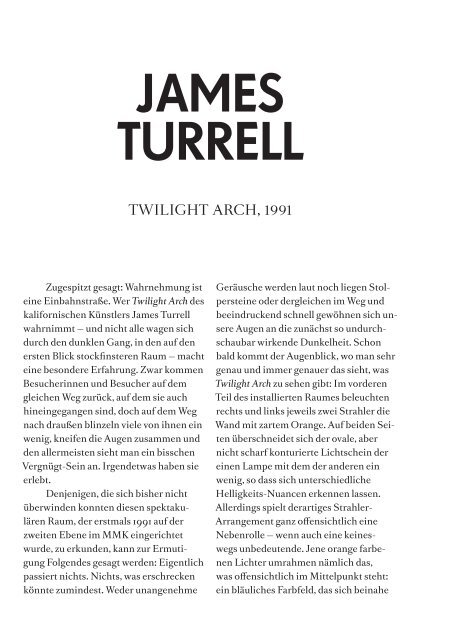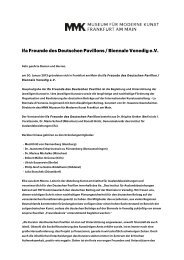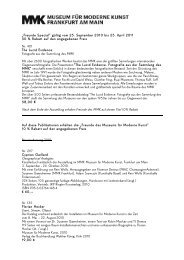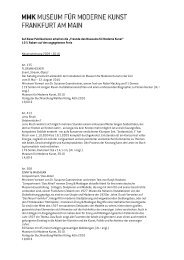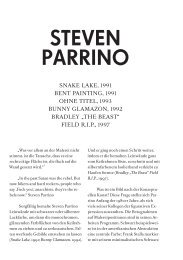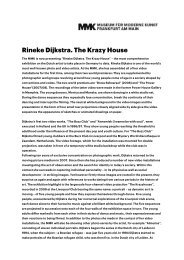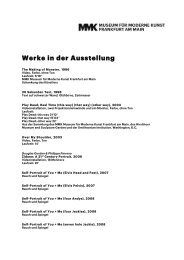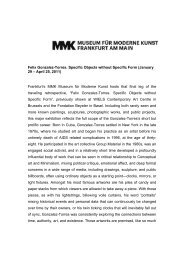PDF zum Download - Museum für Moderne Kunst
PDF zum Download - Museum für Moderne Kunst
PDF zum Download - Museum für Moderne Kunst
Create successful ePaper yourself
Turn your PDF publications into a flip-book with our unique Google optimized e-Paper software.
Zugespitzt gesagt: Wahrnehmung ist<br />
eine Einbahnstraße. Wer Twilight Arch des<br />
kalifornischen Künstlers James Turrell<br />
wahrnimmt — und nicht alle wagen sich<br />
durch den dunklen Gang, in den auf den<br />
ersten Blick stockfinsteren Raum — macht<br />
eine besondere Erfahrung. Zwar kommen<br />
Besucherinnen und Besucher auf dem<br />
gleichen Weg zurück, auf dem sie auch<br />
hineingegangen sind, doch auf dem Weg<br />
nach draußen blinzeln viele von ihnen ein<br />
wenig, kneifen die Augen zusammen und<br />
den allermeisten sieht man ein bisschen<br />
Vergnügt-Sein an. Irgendetwas haben sie<br />
erlebt.<br />
Denjenigen, die sich bisher nicht<br />
überwinden konnten diesen spektakulären<br />
Raum, der erstmals 1991 auf der<br />
zweiten Ebene im MMK eingerichtet<br />
wurde, zu erkunden, kann zur Ermutigung<br />
Folgendes gesagt werden: Eigentlich<br />
passiert nichts. Nichts, was erschrecken<br />
könnte <strong>zum</strong>indest. Weder unangenehme<br />
JAMES<br />
TURRELL<br />
TWILIGHT ARCH, 1991<br />
Geräusche werden laut noch liegen Stolpersteine<br />
oder dergleichen im Weg und<br />
beeindruckend schnell gewöhnen sich unsere<br />
Augen an die zunächst so undurchschaubar<br />
wirkende Dunkelheit. Schon<br />
bald kommt der Augenblick, wo man sehr<br />
genau und immer genauer das sieht, was<br />
Twilight Arch zu sehen gibt: Im vorderen<br />
Teil des installierten Raumes beleuchten<br />
rechts und links jeweils zwei Strahler die<br />
Wand mit zartem Orange. Auf beiden Seiten<br />
überschneidet sich der ovale, aber<br />
nicht scharf konturierte Lichtschein der<br />
einen Lampe mit dem der anderen ein<br />
wenig, so dass sich unterschiedliche<br />
Helligkeits-Nuancen erkennen lassen.<br />
Allerdings spielt derartiges Strahler-<br />
Arrangement ganz offensichtlich eine<br />
Nebenrolle — wenn auch eine keineswegs<br />
unbedeutende. Jene orange farbenen<br />
Lichter umrahmen nämlich das,<br />
was offensichtlich im Mittelpunkt steht:<br />
ein bläuliches Farbfeld, das sich beinahe
über die ganze Wandfläche an der Stirn-<br />
seite des Raumes ausdehnt. Die recht-<br />
eckige Form kommt gleichermaßen<br />
strahlend und dunkel daher, wirkt dicht<br />
und transparent und erscheint sowohl<br />
<strong>zum</strong> Greifen nah als auch weit, weit weg.<br />
Wenn man so will, hat sie tatsächlich et-<br />
was von dem, was Walter Benjamin als<br />
Qualität <strong>für</strong> seine berühmte „Aura“ be-<br />
schreibt: „Ein sonderbares Gespinst von<br />
Raum und Zeit: einmalige Erscheinung<br />
einer Ferne, so nah sie sein mag.“ 1 Umge-<br />
ben vom Dunkel und eingerahmt vom<br />
komplementären Orange kann dieser ul-<br />
traviolette Schein umso eindrucksvoller<br />
scheinen: ein bisschen so wie ein gerade<br />
eben erst abgeschalteter Fernsehmonitor,<br />
wenn er noch nachglüht; aufgrund des<br />
riesigen Formats aber eher wie die Pro-<br />
jektionsfläche im Kino, jedoch in einem<br />
so kräftig-diffusen Blauton, wie man ihn<br />
nur ganz selten am zwielichtigen Himmel<br />
in der Dämmerung sehen kann. Dieses<br />
Licht leuchtet ohne offensichtliche Quel-<br />
le — ganz gleichmäßig, ohne zu flackern,<br />
ganz ebenmäßig, ohne zu modellieren.<br />
Für Turrell, der sich seit Mitte der<br />
Sechziger Jahre mit Licht-Räumen und<br />
-Objekten beschäftigt, zählt Twilight Arch<br />
zu den sogenannten „Space Divsion<br />
Constructions“. Installationen also, die<br />
den Raum in zwei Bereiche aufteilen,<br />
einen Betrachtungsraum („viewing<br />
space“) diesseits und einen Wahrneh-<br />
mungsraum („sensing space“) jenseits<br />
der Wand, die hier als Trennung eingezo-<br />
gen wurde. Wenn dabei von Zweiteilung<br />
(„Space Division“) die Rede ist, dann<br />
macht das nur hinsichtlich einer vorläu-<br />
figen Beschreibung der Raumsituation<br />
Sinn. Streng genommen erfüllt dieser<br />
‚Raumteiler’ nämlich kaum trennende als<br />
vielmehr eine verbindende Funktion zwi-<br />
schen beiden Bereichen: Durch eine<br />
viereckige horizontale Öffnung, wie sie<br />
sich in großem Format in der Wand auf-<br />
tut, sind beide Raumabschnitte miteinan-<br />
der verbunden. Hier trifft der eine auf<br />
den anderen. Ohne ineinander über zu<br />
gehen scheinen sie sich sachte zu berühren<br />
und vor allem durch ihre unterschiedlichen<br />
Licht-Qualitäten wechselseitig zu<br />
verstärken: zurückhaltendes Orange<br />
einerseits und bei längerem Hinsehen<br />
immer durchdringenderes Blau andererseits.<br />
Mehr und mehr tritt das eine vor<br />
dem anderen zurück, schenkt ihm Raum<br />
und was man schließlich sieht, ist ein Bild<br />
in tiefstem Blau.<br />
Über die rechteckige Form des Ausschnitts<br />
sagt Turrell, dass sie in unserer<br />
Kultur neutral sei. 2 Allerdings ist es gleichzeitig<br />
ein äußerst prägendes, durchaus<br />
dominierendes Format: von architektonischen<br />
Motiven, über das Blatt Papier<br />
und nicht zuletzt bis hin <strong>zum</strong> Bild ganz<br />
allgemein. Dass dann, erst recht innerhalb<br />
einer <strong>Kunst</strong>ausstellung jenes frei gelassene<br />
Rechteck vorläufig als Bildfläche<br />
wahrgenommen wird, liegt auf der Hand<br />
(<strong>zum</strong>al wenn zu dessen Seiten Spots angebracht<br />
sind). Denn das Tafelbild entspricht<br />
dem, was unsereins im <strong>Museum</strong>sraum<br />
erwartet und unmittelbar wiedererkennt.<br />
An diese Konventionen knüpft<br />
Turrell an, allerdings ohne sie zu bedienen.<br />
Er verweist lediglich darauf und<br />
spielt „mit dem Anschein [...] des Vertrauten<br />
im Unvertrauten.“ 3<br />
Gerade weil die Fläche und der<br />
Raum dahinter buchstäblich leer sind, lassen<br />
sie sich umso mehr mit Assoziationen<br />
füllen. Der Übergang vom einen in den<br />
anderen räumlichen Bereich funktioniert
als Projektionsfläche: Hier zeigt sich das,<br />
was wir sehen, weil wir es sehen können<br />
und sehen wollen; und zwar genau so, wie<br />
es innerhalb unseres kulturellen Kontex-<br />
tes vorgesehen ist. In Zeiten, in denen<br />
man mehr denn je darüber forscht, dass<br />
nicht nur unser Auge, sondern immer<br />
auch — noch zudem in besonders einflussreichem<br />
Maße — unser Gehirn Gesehenes<br />
erkennt, ergänzt und überhaupt<br />
erst fassbar macht, verweist eine solche<br />
zu füllende Bildfläche am deutlichsten<br />
auf das Sehen an sich. Hinsichtlich der<br />
<strong>Kunst</strong> von James Turrell kann man also<br />
das Sehen sehen. Das grundlegende<br />
Arbeitsmaterial, was hier sowohl als Forschungsgegenstand<br />
wie auch als künstlerisches<br />
Gestaltungsmittel <strong>zum</strong> Einsatz<br />
kommt, ist Licht. Das ist ebenso naheliegend<br />
wie faszinierend, ebenso simpel<br />
wie komplex. Denn Licht, das ist die Bedingung<br />
und Basis allen Sehens, vollkommen<br />
unabhängig davon, ob man<br />
Alltägliches oder <strong>Kunst</strong> sieht, ob eine<br />
Briefmarke, einen Kinofilm, ein Gemälde<br />
oder Twilight Arch. Auf vielschichtige<br />
Weise erfüllt Licht erhellende, ja vielleicht<br />
sogar erleuchtende Funktion und zeigt<br />
sich in diesem Fall als basales Medium<br />
zur Wahrnehmung und Erkenntnis: Je<br />
genauer man hinsieht, desto mehr versteht<br />
man, um was es sich bei diesem<br />
<strong>Kunst</strong>werk augenscheinlich handelt.<br />
Glaubt man aus einiger Distanz in der<br />
strahlenden Fläche eine räumliche Begrenzung<br />
zu sehen, dehnt dieselbe sich<br />
irgendwann in die Tiefe aus und eröffnet<br />
eine ganz neue Perspektive: Die Farbfläche<br />
wird <strong>zum</strong> Farbraum, der schlichte<br />
Guckkasten <strong>zum</strong> Wahrnehmungsspielraum.<br />
Vage, aber doch zu erkennen, zeigen<br />
sich in der Folge die Kanten dieser<br />
Sphäre, so dass man ihre Dimensionen<br />
abschätzen kann.<br />
Voraussetzung <strong>für</strong> derartige phänomenale<br />
Wirkung sind zwar eine perfekte<br />
Konstruktion und Technik, doch werden<br />
sie keineswegs <strong>zum</strong> Selbstzweck innerhalb<br />
der künstlerischen Arbeit, sondern<br />
bleibt stets Mittel <strong>zum</strong> Zweck des Spiels<br />
von Licht und Wahrnehmung, von <strong>Kunst</strong>werk<br />
und denjenigen, die es betrachten.<br />
Leuchtstoffröhren, die Schwarzlicht ausstrahlen,<br />
rahmen das Sichtfenster von der<br />
dem Publikum im Grunde verborgenen<br />
Gegenseite der Stellwand. Von ihnen<br />
geht dieses äußerst milde, aber doch so<br />
eindringliche blaue Strahlen aus.<br />
Sagt man, dass in Twilight Arch<br />
nichts passiert, so trifft das ebenso wenig<br />
zu, wie die Behauptung, dass der da<strong>für</strong><br />
installierte Raum leer sei. Zweifellos ist<br />
der Platz weder vor noch hinter der Trennwand<br />
besetzt mit Objekten und Motiven,<br />
die der Künstler uns gegenständlich vor<br />
Augen führt. „Ich verwende in meinen<br />
Arbeiten keine Objekte“, formuliert Turrell,<br />
„weil ich nicht will, daß das Licht<br />
Material erhellt, vielmehr möchte ich<br />
das Licht selbst materialisieren.“ 4 Deshalb<br />
ist es zutreffend, diesen titanweiß<br />
gestrichenen, architektonisch äußerst<br />
zurückhaltenden Leerraum nach dem<br />
französischen <strong>Kunst</strong>philosophen George<br />
Didi-Huberman als „Freiraum“ zu beschreiben.<br />
Befreit von Dingen, die leicht<br />
benannt werden könnten, entfaltet sich<br />
hier nämlich die „reine und einfache visuelle<br />
Kraft des lichterfüllten Zwischenraums.“ 5<br />
Denn wo sich auf den ersten Blick nichts<br />
Konkretes erkennen und daher auch<br />
nichts sprachlich fixieren lässt, bleibt<br />
Wahrnehmung aufmerksam und es gilt,<br />
umso genauer hinzusehen. In der Rezep-
tion von Twilight Arch geht es darum, sich<br />
schrittweise anzunähern, sehend heranzutasten,<br />
bis man in der Tat „begreifen“ 6<br />
kann, was sich so präsent und im selben<br />
Augenblick so unnahbar zeigt. Was pas-<br />
siert, ist das Rezeptionserlebnis selbst.<br />
„Darum gibt es kein Objekt, das Ziel ist die<br />
Wahrnehmung. Sie ist das eigentliche<br />
Objekt.“ 7 Allerdings nicht missverstanden<br />
als eingeschliffenes, bloßes Wiedererken-<br />
nen, sondern aufgefasst im Sinne von<br />
aktivem Wahr-Nehmen, wie es sich nicht<br />
nur wandelt, sondern vor allem intensi-<br />
viert. Zumindest mit ein bisschen Geduld.<br />
Dass Zeit eine wesentliche Rolle bei<br />
Twilight Arch spielt, ebenso wie bei ande-<br />
ren Arbeiten James Turrells, lässt sich<br />
erst einmal anhand der allmählichen Sen-<br />
sibilisierung der Augen in der Dunkelheit<br />
nachvollziehen. Nicht nur stehen im<br />
Laufe des Rezeptionsprozesses Sehge-<br />
wohnheiten in Frage. Ganz grundsätzlich<br />
wird ein Wahrnehmungserlebnis veranlasst,<br />
das auf diversen Ebenen feinfühlig<br />
macht <strong>für</strong> die sinnliche Komplexität dieses<br />
<strong>Kunst</strong>werks. Bei aller äußerlicher<br />
Schlichtheit, ja fast schon Strenge, gleiten<br />
die verschiedenen Gegensatzpaare zu<br />
einem komplexen Geflecht ineinander:<br />
helles und dunkles Licht, direktes und indirektes,<br />
visuelle und taktile Qualitäten,<br />
Reales und Virtuelles, Materielles und<br />
Immaterielles. All das einmal wahrzunehmen,<br />
bedeutet vor allem Genuss, weshalb<br />
man gern zu Twilight Arch wiederkommen<br />
mag. Jedoch schließt derartig intensives<br />
Seh-Ereignis jedes Davor aus. Der<br />
erste Eindruck, die erste Verblüffung lassen<br />
sich nicht wiederholen. Wie gesagt:<br />
Wahrnehmung ist eine Einbahnstraße.<br />
Jule Hillgärtner<br />
JAMES TURRELL<br />
(*1943, Los Angeles, USA — lebt in<br />
Flagstaff und Inishkeame, Irland)<br />
TWILIGHT ARCH, 1991<br />
Neonlicht<br />
<strong>Museum</strong> <strong>für</strong> <strong>Moderne</strong> <strong>Kunst</strong>,<br />
Frankfurt am Main<br />
Inv. Nr. 1988/7.1-16<br />
1 Walter Benjamin: Kleine Geschichte der<br />
Fotografie, in: Gesammelte Schriften II, Frankfurt<br />
am Main 1977, S. 378<br />
2 James Turrell im Gespräch mit Andrea Jonas-<br />
Edel: Die Körperlichkeit des Lichts offenbaren, in:<br />
<strong>Kunst</strong>-Bulletin, Jan./Feb. 1996, S. 13<br />
3 Axel Müller: Aus der Grenze der Materialität:<br />
Turrells ‚Licht-Bilder’, in: Kritisches Lexikon der<br />
Gegenwartskunst, München 1994, S. 7<br />
4 James Turrell, in: Jiri Svestka (Ed.): Perceptual<br />
Cells, Stuttgart 1992, S. 65<br />
5 George Didi-Hubermann: Die Fabel des<br />
Ortes, in: Peter Noever, MAK (Hg.): James Turrell.<br />
The Other Horizon, Ostfildern-Ruit 1999, S. 32.<br />
(Hervorhebung im Original)<br />
6 „Begreifen“, das heißt sowohl berühren als<br />
auch sprachlich benennen und intellektuell verstehen,<br />
was vor uns erscheint. Wodurch wir uns als<br />
Betrachterinnen und Betrachter von Turrells Arbeit<br />
von jenen Menschen unterscheiden, die gefesselt<br />
in Platons Höhle sitzen und nichts mehr von der<br />
Wirklichkeit zu sehen bekommen als deren Schattenbilder,<br />
die auf der Felswand ihnen gegenüber<br />
vorüberziehen.<br />
7 James Turrell, in: Jiri Svestka (Ed.): Perceptual<br />
Cells, Stuttgart 1992, S. 65
JAMES TURRELL<br />
TWILIGHT ARCH, 1991<br />
Let us make no bones about it: per-<br />
ception is a one-way street. Anyone who<br />
perceives California artist James Turrell‘s<br />
Twilight Arch — and not everyone ventures<br />
through the dark passageway into what<br />
appears at first sight to be a pitch-black<br />
room — experiences something special.<br />
The visitors leave the room the same way<br />
they entered it, but many of them come<br />
out squinting, and the majority appear a<br />
bit amused. They have obviously experi-<br />
enced something.<br />
This spectacular room was first in-<br />
stalled on the second level of the MMK<br />
in 1991. We can encourage those who<br />
have not yet brought themselves to ex-<br />
plore it by saying: actually, nothing hap-<br />
pens in it at all. At least nothing scary.<br />
Neither unpleasant sounds are heard, nor<br />
is exploration encumbered by any stum-<br />
bling blocks. What is more, however in-<br />
scrutable the darkness may seem at first,<br />
our eyes accustom themselves to it with<br />
astonishing speed. It is not long before<br />
we see, very exactly and ever more exactly,<br />
what Twilight Arch has to offer: in the<br />
front section of the installed space, two<br />
spotlights each to the left and right illuminate<br />
the wall a delicate orange. On<br />
both sides, the oval — but not sharply<br />
contoured — beam of the one lamp slightly<br />
overlaps that of the other, revealing<br />
subtle variations in the brightness. Yet<br />
the arrangement of the spotlights is evidently<br />
a matter of secondary importance,<br />
though by no means entirely unimportant.<br />
As it turns out, the orange-coloured<br />
lights serve to frame that which is apparently<br />
the centre of attention: a bluish<br />
colour field spreading across almost the<br />
entire surface of the wall at the far end of<br />
the space. The rectangular form possesses<br />
a quality both radiant and dark, dense<br />
and transparent, appears close enough<br />
to touch and at the same time extremely<br />
far away. It actually shares something of
what Walter Benjamin described as a<br />
quality of his famous “aura”: “a peculiar<br />
weave of space and time: unique appari-<br />
tion of a distance, however near it may<br />
be.” 1 Surrounded by darkness and framed<br />
by the complementary shade of orange,<br />
this ultraviolet glow is all the more strik-<br />
ing — a bit like the afterglow of a TV<br />
screen just turned off an instant ago, due<br />
to the huge format, however, more like a<br />
cinema screen, but in the strong and dif-<br />
fuse shade of blue witnessed with the ut-<br />
most rarity in the twilit sky at dusk. This<br />
light shines without any apparent source,<br />
entirely constantly, without flickering,<br />
entirely evenly, without modelling.<br />
Turrell has been preoccupied with<br />
light-spaces and light-objects since the<br />
mid 1960s. He classifies Twilight Arch as<br />
one of his so-called “Space Division Constructions”.<br />
These are installations which<br />
divide the space into two areas, a viewing<br />
space on the near side and a perception or<br />
“sensing” space on the other side of the<br />
wall erected here as a divider. The use of<br />
the term “space division”, however, makes<br />
sense only with regard to a preliminary<br />
description of the spatial situation. For,<br />
strictly speaking, the “partition” has<br />
much more of a connective than a divisive<br />
function between the two sections of<br />
the space. As seen here on a large scale, a<br />
kind of window opens up onto the back<br />
wall and serves to connect the two areas;<br />
it is here that they meet. Without merging,<br />
they appear to touch each other gently,<br />
even to reinforce one another, above all<br />
through their differing light qualities: on<br />
the one hand a subdued orange, on the<br />
other hand a blue which becomes more<br />
pervasive the longer we look at it. Increasingly,<br />
the one makes way for the<br />
other, gives it space, and what we ultimately<br />
see is an image in the deepest of<br />
all blues.<br />
Turrell says that in our culture the<br />
rectangular form is neutral. 2 At the same<br />
time, it is an extremely distinctive, even<br />
dominant, format, the format of architecture,<br />
the piece of paper, the picture in<br />
general. It is entirely par for the course,<br />
then, that this blank rectangle is perceived<br />
as a picture surface — all the more<br />
so in view of the setting, an art exhibition,<br />
and the fact that spotlights have been installed<br />
on either side. The panel painting<br />
corresponds to what we expect to find in<br />
a museum gallery, is something we recognize<br />
immediately. Turrell makes reference<br />
to these conventions, but does not<br />
cater to them. He merely alludes to them,<br />
and plays “with the appearance [...] of the<br />
familiar in the unfamiliar”. 3<br />
Due precisely to the fact that the<br />
surface and the space behind it are literally<br />
empty, they can be filled all the more<br />
with associations. The point of transition<br />
from the one spatial area to the other<br />
serves as a projection surface. What appears<br />
here is that which we see because<br />
we can see it and want to see it, in exactly<br />
the manner intended within our cultural<br />
context. These days, more research than<br />
ever is being carried out on the following<br />
phenomenon: it is not only the eye that<br />
recognizes what we see but also — and to<br />
an especially influential degree — the<br />
brain, which supplements the image, and<br />
without which the image would not be<br />
comprehensible. In this context, we can<br />
think of an empty picture surface inviting<br />
us to fill it more than anything as an allusion<br />
to sight itself. In the art of James<br />
Turrell, it is literally possible to see sight.
The basic working material, capable of<br />
serving both as a research subject and an<br />
artistic medium, is light. That is a circum-<br />
stance as obvious as it is fascinating, as<br />
simple as it is complex. For light is the<br />
condition and basis of all sight, completely<br />
regardless of whether it is the everyday<br />
world or art we are looking at, whether a<br />
postage stamp, a movie, a painting or<br />
Twilight Arch. In a complex manner, light<br />
serves an illuminating, perhaps even an<br />
enlightening function, and reveals itself<br />
here as a fundamental medium of perception<br />
and recognition: the longer we look,<br />
the more we understand what this artwork<br />
is evidently about. If from a certain<br />
distance the glowing surface looks like a<br />
spatial boundary, at some point that surface<br />
gives way into the depths and opens<br />
up an entirely new perspective. The colour<br />
surface becomes a colour space, the<br />
simple peep box an entire perceptual<br />
spectrum. The edges of this sphere, if<br />
hazy, are discernible, enabling us to judge<br />
its dimensions.<br />
The prerequisite for such a phenomenal<br />
effect is perfect construction and<br />
technology. The latter are by no means<br />
an end in themselves within the artwork,<br />
however, but consistently the means to<br />
an end — a play on light and perception,<br />
on the artwork and those who view it.<br />
Fluorescent tubes radiating black light<br />
frame the “viewing window” of the partition<br />
from the side hidden to view. It is<br />
they which emit this extremely mild, but<br />
nevertheless so powerful blue gleam.<br />
If we say that nothing happens in<br />
Twilight Arch, it is just as wrong as claiming<br />
that the room in which it is installed<br />
is empty. Neither before nor behind the<br />
partition is the space occupied by any<br />
objects or motifs. “I don’t use any objects<br />
in my works,” explains Turrell, “because I<br />
don’t want the light to illuminate material.<br />
What I want is to materialized the light<br />
itself.” 4 It is thus accurate to describe this<br />
titanium-white-painted, architecturally<br />
extremely unobtrusive empty space as a<br />
“free space”, in the sense of the term coined<br />
by French art philosopher George<br />
Didi-Huberman. In a space freed of readily<br />
identifiable things, what comes into<br />
its own is the “pure and simple visual<br />
power of the light-filled interspace.” 5 For<br />
where we recognize nothing specific at<br />
first sight and can accordingly identify<br />
nothing verbally, our perception remains<br />
alert and we look all the more closely.<br />
The reception of Twilight Arch is a process<br />
of gradual approximation, of visually<br />
groping our way forward until we can indeed<br />
“grasp” 6 that which possesses such<br />
presence and is at the same time so unapproachable.<br />
What “happens” is the experience<br />
of reception itself. “That’s why<br />
there’s no object; the aim is perception.<br />
That’s the actual object.” 7 Not perception<br />
misunderstood as mere ingrained recognition,<br />
but conceived of in the sense of<br />
active perception, in its process of change<br />
— and above all its process of constant<br />
intensification. At least with a bit of patience.<br />
Time plays as essential a role in<br />
Twilight Arch as it does in other works<br />
by James Turrell, a circumstance already<br />
evident in the gradual adaptation of the<br />
eyes to the darkness. Not only visual<br />
habits are questioned in the course of the<br />
process of reception. Quite fundamentally,<br />
the Arch brings about a perceptual<br />
experience which sensitizes us on various<br />
levels to the sensual complexity of this
artwork. However simple — even austere —<br />
it is on the surface, various pairs of oppo-<br />
sites glide together to form a complex<br />
nexus of bright and dark, the direct and<br />
the indirect, the visual and the tactile,<br />
the real and the virtual, the material and<br />
the immaterial. To perceive all of that together<br />
is above all a pleasure, which is<br />
why we like to come back to Twilight Arch.<br />
A visual occurrence of such intensity,<br />
however, precludes any “beforehand”.<br />
The first impression, the first amazement,<br />
cannot be repeated. Perception, we may<br />
recall, is a one-way street.<br />
Jule Hillgärtner<br />
Translation: Judith Rosenthal<br />
MMK MUSEUM FÜR MODERNE KUNST<br />
FRANKFURT AM MAIN<br />
JAMES TURRELL<br />
(*1943, Los Angeles, USA — lives in<br />
Flagstaff and Inishkeame, Ireland)<br />
TWILIGHT ARCH, 1991<br />
Neon light<br />
<strong>Museum</strong> <strong>für</strong> <strong>Moderne</strong> <strong>Kunst</strong>,<br />
Frankfurt am Main<br />
Inv. no. 1988/7.1-16<br />
1 Walter Benjamin, Kleine Geschichte der Fotografie,<br />
Gesammelte Schriften II, Frankfurt/Main,<br />
1977, p. 378<br />
2 James Turrell im Gespräch mit Andrea<br />
Jonas-Edel: Die Körperlichkeit des Lichts offenbaren,<br />
<strong>Kunst</strong>-Bulletin, Jan./Feb. 1996, p. 13<br />
3 Axel Müller, Aus der Grenze der Materiali-<br />
tät: Turrells ‘Licht-Bilder’, Kritisches Lexikon der<br />
Gegenwartskunst, Munich, 1994, p. 7<br />
4 James Turrell, Perceptual Cells. Edited by Jiri<br />
Svestka, Stuttgart, 1992, p. 65<br />
5 George Didi-Hubermann, Die Fabel des<br />
Ortes, in James Turrell. The Other Horizon. Edited<br />
by Peter Noever, MAK, Ostfildern-Ruit, 1999, p. 32<br />
(italics in original).<br />
6 “To grasp”, in other words to touch as well<br />
as to identify verbally and understand intellectually<br />
what appears in front of us. The factor distinguishing<br />
us from those sitting captive in Plato’s cave and receiving<br />
nothing more to see of reality than its shadows<br />
passing across the rock wall they face.<br />
7 James Turrell 1992 (see note 4), p. 65


